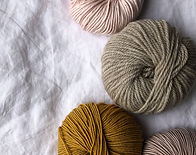

WHY USE ALPACA ?
A Versatile Natural Fibre
Alpaca fleece is the one of world’s finest natural fibres ; soft as cashmere, smooth as silk and warmer, lighter and stronger than wool. Alpacas are members of the camelid family, one of four sub-species native to the Andean region of South America. Raised in their natural habitat of the Altiplano, or high plateau of Southern Peru, Bolivia and Chile, the Alpaca has developed more thermal capacity in it's fiber than almost any other animal. Alpaca fiber is also considered to be hypo-allergenic, especially the ultra-fine, premium grades. . . The most valuable alpaca fiber is that of baby alpaca, which is softer and finer than the fleece of the adult animal. Baby alpaca is not from a baby animal, but it is the first shear on a young animal.
The Luxurious Feel of Alpaca against the Skin
Alpaca fiber has a thermal nature as the result of the hollow core of follicle and the lack of natural oils in the alpaca's coat. Thus, alpaca fabric is lightweight, "breathes" and keeps you comfortably warm. The hypo-allergenic qualities derive from the absence of natural oils particularly lanolin. A further benefit is that the fibre generates a very low electrostatic charge.
The smooth surface of each follicle eliminates the "prickle effect" associated with more coarse fibers and contributes to the exquisite luster and luxury of alpaca fleece.
Natural Resin Deliver Benefits
Alpaca fibres contains a natural resin called squint which provides a built-in resistance to water, repelling fog and misty rain. The natural resin also increases the strength of the fibre preventing aging and soil absorption and ultimately resists pilling, wrinkling, and staining. These natural resins result in negligible shrinkage during washing, relative to other fabrics.
Natural Colours and Dyed Colours
Alpaca fleece comes in 22 natural colors ranging from pure white through to a true jet black and colors shade out from steel blue to pale silver and even a vibrant rose-grey, and mahogany! While alpacas come in many natural colors - more than any other fiber-producing animal - their fiber retains its luster even when dyed with non-chemical dyes. You can see by browsing alpaca catalogues that these fabrics can be dyed to any colour from the palest off-white to vibrant primary colours and to all shades in between.
Thermal Performance Superior to that of Wool
Alpaca is thermostatically superior of wool, in fact up to three times superior for the same thickness of fabric. Another factor which makes alpaca fibre a superior insulator is the fact that body moisture passes through the fabric by wick action ( the fibres are hollow ) eliminating dampness and loss of insulating effect.
Because of this superior thermal performance and the superior fibre strength , alpaca fabrics can be woven into very thin textiles which are light and very suitable for the milder climates which we experience in the temperate parts of Australia. These lightly woven fabrics provide comfort in a wide range of cool to cold conditions.
Fire Resistance
Alpaca is one of the least flammable and difficult to ignite of all fabrics. If forced it will burn with a slow spreading flame which is easy to extinguish . The residue of burnt alpaca forms a dry ash that doesn't stick to skin.
There is no reason not use alpaca so please consider investing in a quality alpaca garment which will keep you comfortable through a range of seasons and enhance your personal style around town.


